Are you a new entrepreneur or startup trying to increase brand awareness? You’ve probably realized media coverage is a great way to establish your presence. Or maybe you’ve been using Help a Reporter Out (HARO) for a while now, but you haven’t had much success. You get press coverage or two once in a while, but you feel that your pitch emails are largely ignored. What could have gone wrong?
You could be missing some essential ingredients of a good media pitch email that can get journalists’ attention.
We understand the frustrations, especially when you’re starting out pitching journalists and doing public relations outreach. So, we’ve gathered some of the best media pitch examples we had based on our writers’ and clients’ experiences.
Below, you’ll find media pitch examples that landed press coverage on published articles from publications with high domain authorities. Think Forbes, Business Insider, Bustle, The Wall Street Journal, and The Huffington Post.
Stick with us until the end so you don’t miss out on essential tips that can help you win media coverage from your target publications.
Let’s dive in!
What Is A Media Pitch?
For the uninitiated, a media pitch is a concise email sent to a journalist, an editor, or an influencer. The goal is to get media coverage for your brand, which will boost your brand awareness, authority, credibility, and search engine optimization (SEO) initiatives.
A media pitch is tailored to the journalist’s interests or the publication’s niche. So, you need to do some research to know this information beforehand.
It’s easier to know what you can contribute if you use outreach platforms like HARO. In this platform, journalists post requests for expert insights and specify what they’re looking for.
While they give you media coverage, you’re also helping them add value and meat to their content, so that’s a mutual benefit.

Media Pitch vs. Press Release: What’s the Difference?
Traditionally, brands get media coverage by publishing press releases that media outlets can use as an official reference. Press releases are best for company events and announcements.
But in today’s media environment, media pitches are the best way to get noticed by publications so that you can tell your brand story and get featured.
Now, there are different kinds of press pitches:
You can pitch complete content, meaning that you’ve written a whole article and pitch it to the media outlet as a guest post.
You can pitch a content idea based on the needs of the publication. For example, some media outlets provide a submission guideline on their websites and ask you to pitch a topic. Then, when they’ve approved it, you’ll be provided more guidelines on creating an outline and structure for it and then the full version.
You can also pitch expert insights through PR outreach and link-building platforms like HARO. The journalists submit a query that you can answer, and when they pick your insights, you’ll be quoted. Many publications also give a backlink to your website.
In this post, we will talk more about the third kind of PR pitches and how we can make more effective media pitch emails.
The Anatomy of a Media Pitch Email
What are the usual details that your media pitch email should contain?
When you create a media pitch template, make sure it contains the following:
Email subject line
Your email pitch must have a subject line that will catch the journalist’s attention. However, it should stay relevant to your pitch.
There’s minimal space to work on if you’re using HARO because the emails are usually sent automatically with a subject line that looks like this: “HARO: New Pitch – [First 20 characters of your subject line]…”. So in that 20 characters, our suggestion is to include a keyword or your expertise.
For example: “CPA source on trends…”.
If you have the direct email of the journalist, you have more leverage with the subject lines. Just avoid some spam trigger words that could send your email into their Spam folder or Promotions inbox.
Here are some examples of words to avoid in the subject line of your email pitch:
Buy
Order
As seen on
Near you
Earn $
Best price
Cash bonus
Free
Click here
Notspam
Subscribe
#1
Introduction
Why would the journalist read the rest of your email pitch?
It’s essential to introduce yourself and explain why you’re qualified to offer expert insights. Sometimes the journalists would indicate very specific requirements and background information.
For example, if the query requires insights from certified nutritionists with a website of DR50+, your intro can be:
“Hi [Writer], I’m Michelle Jones. I’m a licensed nutritionist for StayHealthyForever.com, a DR60 publication providing health information to readers.”
This helps establish your credentials, so the reporter will be interested to read what you have to offer.
Body paragraphs
This is where the meat of your email pitch can be found. The body paragraphs must be clear, concise, and relevant to the pitch query. In addition, it must have creative, direct, and actionable insights.
Provide what the query is asking and avoid uncertainties. You must sound professional and confident with what you say.
It also helps to use some formatting, such as bold fonts, to highlight statements that you can be quoted for.
Likewise, bullet points and short paragraphs (1-2 sentences) make your pitch easy to scan and read. It will be a huge favor for busy journalists who have hundreds of pitches to review to find the best material.
Ideally, your email pitch should only be 100 to 200 words long unless otherwise instructed. However, some journalists would sometimes require 250-300 detailed insights.
Signature
You should have a signature to close it off. Your signature must include your full name, position/title, company name, a link to your website, and contact details.
Some writers may also request that you indicate your pronouns, a link to your LinkedIn profile and Twitter, and a link to your photo. Unfortunately, HARO doesn’t accept attachments. Your alternative option is to send a link to your LinkedIn profile photo or a headshot saved in a cloud storage.
Don’t forget to indicate your contact information here so that the journalist can reach out to you when needed.
What Makes a Good Media Pitch Email?
The success of your PR outreach largely depends on the quality of the media pitch email that you send. So how do you increase your chances of getting media coverage? Here are some good media pitch examples:
A good media pitch has a “copy and pasteable” quotes
Journalists want expert insights that they can quote directly. So, your media pitch email should have quotable statements that are easy to copy and paste into their articles.
Journalists wouldn’t want to make changes at all. That’s why it’s essential to be concise and write your email pitch in complete sentences, including the headers.
Here’s our first media pitch example:
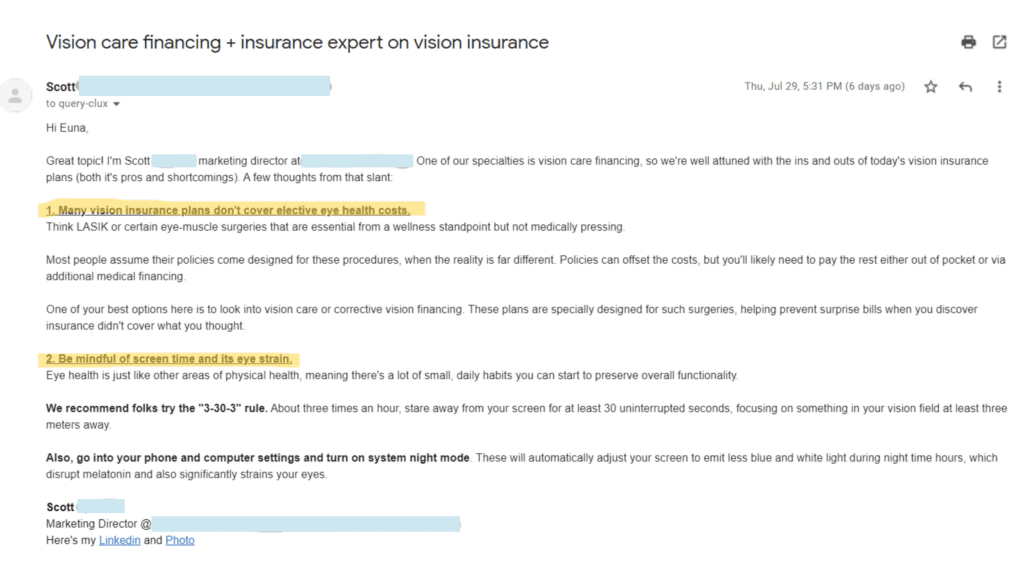
A good media pitch has informative, actionable snippets
Journalists are more likely to use your email pitch when you provide valuable and thoughtful information that will benefit the readers.
Your expert insights should be able to help add depth and practicality to the journalists’ next stories.
Here’s an example:
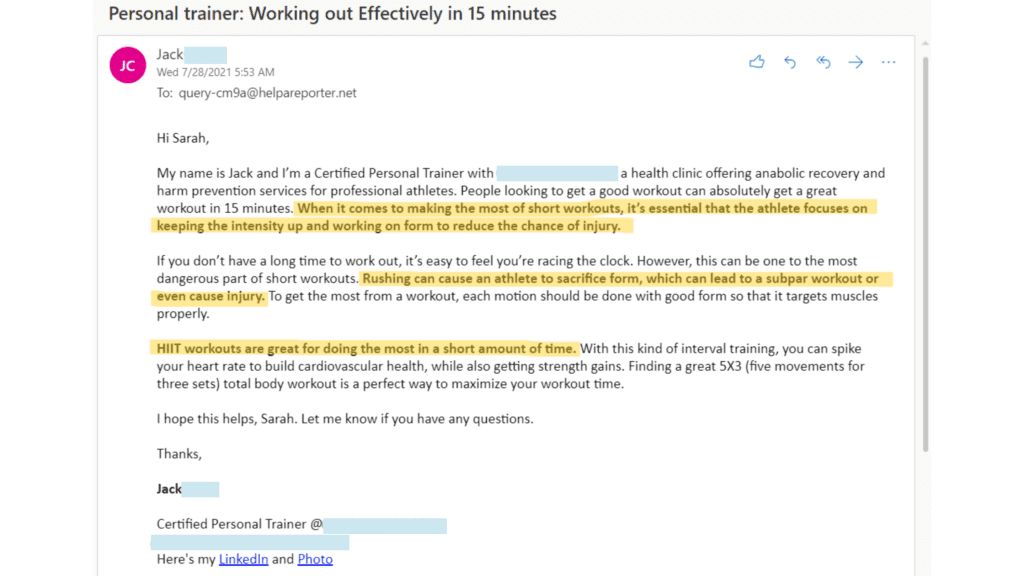
A good media pitch has “meat”
Some journalists would also love to receive detailed pitches. So even when the query is relatively straightforward, you can offer 2-4 thought nuggets, with 2-3 explanations for each.
Sometimes you have to really do in-depth research to write a media pitch that provides more valuable information for the journalists to quote. A good media pitch has more than one idea so that the journalists have more room to work around.
In the example below, you elaborate on 4 key nuggets instead of saying, “Hi [Writer], Small businesses should prioritize NAP information, metadata, long-tail keywords, and image packs to improve local SEO strategies. I’ll be happy to elaborate! Thanks.”
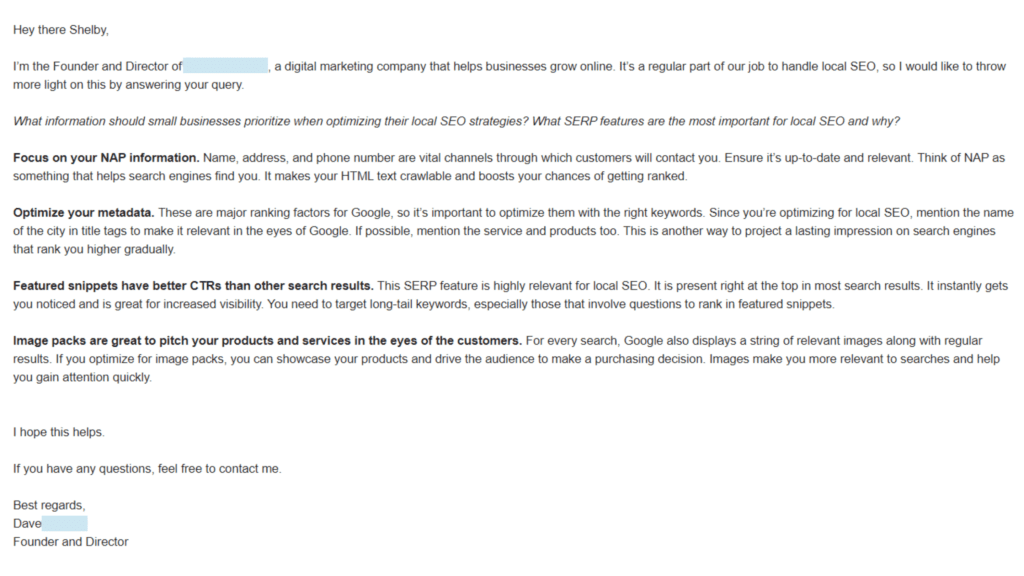
A good media pitch has super relevancy
Your email must be relevant to the journalist and your industry, products, or services. This is super important.
A relevant pitch immediately connects your business or expert background with the query. It means you can establish how you are the perfect fit to answer a specific query and get the media outlet interested.
See this example below. The query is about IT jobs and hiring, and the person who answered not only is a tech executive (CTO), but the company is also a hiring platform. Now that’s super relevancy.
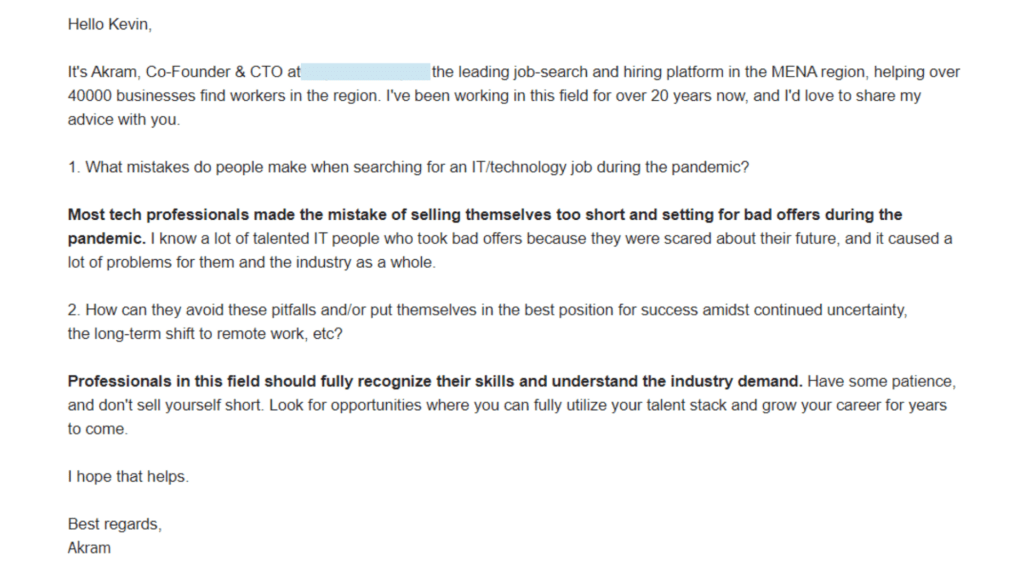
A good media pitch offers something unique
Journalists receive dozens of pitches every day. If they’re using HARO, the numbers could be up to 200+. So chances are, some media relations pitches contain the same insights that you share.
So, one way for your pitch to getting noticed is to provide something unique. For example, you can share a personal experience or think of an uncommon idea or not-so-obvious answer to the query.
Take a look at the example below. The trick here is to search Google for tips on what to do with your tax refund.
What you’ll see on the first page of the SERPs is common information that others might be sending in their media pitches. Avoid them and think of something that’s not so obvious but still relevant.
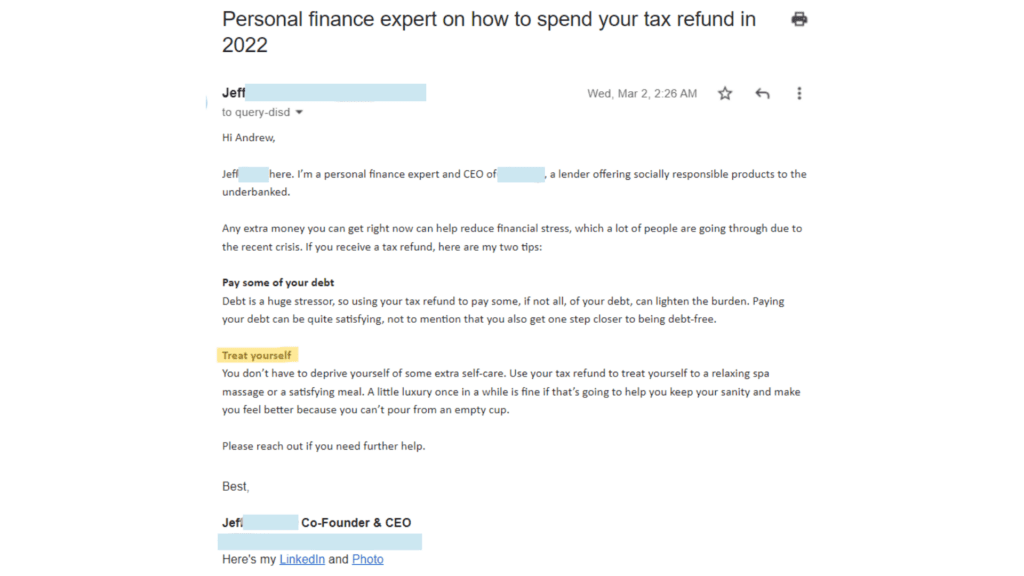
How To Do Media Pitches for Maximum Impact
Now that you have some good media pitch examples and what your email pitches should look like, there are still more that you can do to create a perfect pitch for maximum impact.
Identify Great Topics
You have a wide range of topics to choose from. With HARO, for example, queries can reach around 200 per newsletter. Since you’re receiving three newsletters a day, you could be dealing with about 500-600 topics.
However, not all of them are relevant to your expertise and niche. So, you must be able to identify great topics to prioritize.
Focus on the topics that best fit your brand and credentials. These would usually jump out at you as relevant and something you can answer confidently.
You may also consider your daily job and responsibilities, career history, education, special skills, and insider knowledge when choosing a topic. You need to be strategic about picking the right queries for maximum success.
Do Your Research
Even when you know the topic really well, it also helps to research more before pitching. In addition, it will help ensure that you’re up-to-date with the latest industry news and trends to send more relevant and timely pitches.
Pitch to the Right Media Sources
Like choosing a great topic, it’s also essential to identify the right journalists and publications for your media pitch.
Build a media list based on your niche and industry and the kind of content that you want them to cover.
We’ve written before the top 10 publications for HARO pitching and why we like them. They are:
Business Insider
Healthline
HuffPost
Realtor
Buzzfeed
Forbes
Business News Daily
The Wall Street Journal
Bustle
The New York Times
You may need to look for more industry-specific media sources and influencers if you have specialized content.
Meanwhile, you can also look for specific reporters. For example, many journalists today do freelance work, so they work with various publications but typically cover similar niches.
You can find niche-specific journalists on social media, publication columns or sections, and other PR platforms.
If you’re using HARO, you can take note of the journalists that often send queries on topics relevant to your story.
Pitch As Early As Possible
Have we already mentioned that journalists are busy people and receive hundreds of pitches? You wouldn’t want your pitch to be lost and buried in the middle of those hundreds, so pitching early is crucial.
HARO sends the queries in newsletters three times a day:
5:35 a.m.
12:35 p.m.
5:35 p.m.
It’s helpful to pitch as close as possible to these times so that your pitch arrives in the journalist’s inbox first.
It makes your chances of getting picked and quoted higher because when the writers have already received enough information to quote, they’ll proceed to write their content.
The rest of the pitches that will come after that will be ignored.
Trust me, I learned about this the hard way! First, I used to pitch closer to the deadline. And while I did get some media coverage, I had better success when I started pitching closer to the newsletter release.
I also have my share of sending queries and receiving pitches on HARO. From that perspective, I know that we have deadlines to meet, so we usually settle with the first few good pitches that we receive.
Sometimes the queries would not be released as soon as the reporter submitted them because HARO has to review them first.
Send As Many Pitches As Possible
One of the keys to a successful PR outreach and link-building effort is pitch volume. The more people you reach out to, the more opportunities you have for converting PR pitches and getting coverage.
It’s easier to use media platforms like Sourcery, HARO, and Muck Rack. These tools allow you to find the right journalists and publications and pitch at scale.
If you keep track of your pitch volume versus the media mention you get, you know how many pitches you need to send to hit your target PR coverage.
Keep Your Media Pitch Personalized
Make your PR pitch personalized and not look like a send-to-many message. Always use a greeting and the reporter’s first name.
You can demonstrate that you’re familiar with the media outlet or read a previous work that the journalist wrote before.
Likewise, your pitch must be tailored to the query and the publication. As discussed above, we may have a general media pitch template, but the content should always be customized. You shouldn’t send the exact email pitch to different media outlets.
Similarly, don’t be too stiff and boring with your writing. Write the way you talk, though avoid jargon and flowery words.
You can also comment on how interesting the query is or relate a short experience relevant to the topic. (By short, I mean 1-2 sentences only). Writing with a conversational tone makes your email pitch more personal.
Polish Your Pitch
Make sure that your pitches are error-free before you hit send. Triple check the journalist’s name to make sure that you don’t have spelling mistakes.
Check the facts, ensure that links are working and your grammar is correct. You can strengthen your grammar and writing by using tools like Grammarly and Hemingway App.
Add Shareable Information
Your pitch is likely to get noticed and used when you add shareable information.
Do you have in-house research data that the report can find helpful? Did you create an infographic, graphics, or video clips they may be able to add to their reports?
You can use that shareable information to complement your email pitch.
Expound on a Common Point
While it’s highly recommended that you provide creative and unique insights, don’t undermine the importance of common points.
Sometimes the writer wants to use a common point but needs an expert to cite to add credibility to their content.
When answering a HARO query, our tip is to include one common point and one unique point in your PR pitch. Then, add value to that common point by providing an expert insight or explanation that will make it easier for the readers to understand it.
Don’t Be Overly Self-Promotional
The ultimate goal of pitching is to get earned media mention that will benefit your business.
But when you write your email pitches, you should write it with a mindset that you’re going to provide valuable content for the journalist or news outlet, not promote your brand.
Journalists hate overly self-promotional PR pitches, and many would even warn against that in their queries.
You can promote your products or services very subtly by pitching relevant and great insights.
For example, if you’re offering tree trimming services, your pitch need not mention that specifically.
Instead, you can provide expert insights on the importance of trimming trees in your yard and why it’s best to leave the job to the tree professionals.
Be Patient With Follow-Up
Sending a follow-up email is a necessary step in media pitching, but you need to be patient. You can be persistent but not annoying.
Give it 3-4 days, even a week, to follow up on your pitch. This will allow enough time for the journalist to read your email.
If you don’t hear from the writer on your first attempt of sending a follow-up email, you can reach out one more time after 3-4 days.
Some journalists may use your pitch in a media release even when you have never heard from them. You can send a thank you email to keep the connection if that happens.
Don’t Call
Whether you’re pitching or following up, don’t call. It’s a bad idea. Even when you know the reporter’s contact details or direct line, it can annoy them if you call.
They’re busy enough, so just allow them to get back to you through email when they’re available. Most reporters follow an editorial calendar, so you may not hear from them as early as you would hope.

What Tools Can You Use to Find the Best Media Pitching Opportunities?
You can up your pitching game by leveraging the best tools for finding media opportunities.
Whether pitching long-form content or building quality backlinks, tools make the process more efficient and effective. In addition, you can save time because you don’t have to manually create your media list.
Here are a few tools to consider:
1. Help a Reporter Out (HARO)
HARO is a platform that journalists, PR professionals, and businesses use to connect and find media opportunities.
For journalists, HARO serves as the link to the expert sources that they can use as references for their content.
Direct quotes and expert insights can add value and credibility to their pieces and help them understand their topics better.
For PR professionals and businesses doing their PR in-house, it’s a great platform to start pitching at scale and get backlinks to their sites.
You don’t have to write full articles or lengthy emails. Often, the journalists only need 2-3 sentences that they can quote directly.
When journalists use your pitch, they will include your name, your company, and a link back to your site.
It’s free to join HARO, although it also offers paid subscriptions that give you VIP access to queries before they’re released to the rest of the members.
2. Sourcery
Sourcery also allows you to pitch at scale. It improves HARO by providing more information about the publications and queries so that you can choose the best opportunities for your brand.
These include the following:
the publication’s domain rating (DR)
the publication’s monthly web traffic
link type (whether the media outlet provides do-follow or no-follow links or no link at all)
difficulty score (a Sourcery metric for a successful PR mention)
You can sign up as an individual and PR firms can set up multiple accounts. Additionally, Sourcery gives you coaching and public relations strategy tips to do more effective PR outreach.
3. NinjaOutreach
NinjaOutreach is a CRM platform where you can manage your blogger PR outreach strategies.
Aside from journalists working with top mainstream publications, bloggers are also great people to reach out to for media exposure.
Informational and high-quality blogs are particularly influential when you’re trying to build brand awareness and credibility.
You can use the platform to connect with bloggers, follow them social media channels, establish relationships with them, send your story ideas, and get them to feature your story in a blog post.
4. Muck Rack
Muck Rack is a paid PR management platform that you can use to look for and reach out to prospect media contacts. It keeps an extensive database of verified journalists and aggregates information from writers and organizations that publish news stories worldwide. That makes it easier for you to find relevant journalists based on their beats and interests.
When you find the right person, you can connect with them to build a relationship and create a custom pitch.
Muck Rack also offers monitoring features, which you can use to plan your next story idea and pick a target publication.
Wrapping Up Effective Media Pitch Examples
Pitching your story to media contacts helps build brand awareness, and every mention and link you get can boost your SEO efforts.
Creating email pitches is not that easy, though. It’s more than just writing an email and asking the writer to feature your brand story. Instead, you need to be strategic with your email pitches to generate the maximum public relations benefits.
Again, a good email pitch contains “copy + pasteable” quotes, informative and actionable snippets, essential nuggets, relevancy, and unique insights. Also, also take note of our media pitching tips to ensure that your pitch works and you have a successful PR strategy.

